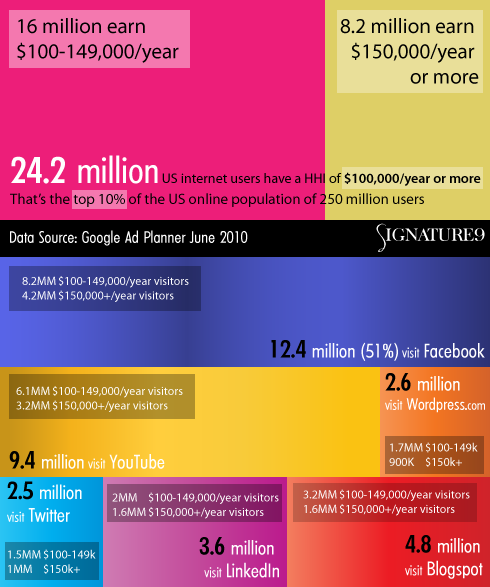Wealthy Web 2.0: Social Media’s Richest Audiences [Infographics]

You may have heard that Facebook recently hit 500 million members. According to Google AdPlanner, in June the popular social network received 540 million unique visitors, so there’s some evidence that the site’s open graph initiative is working in expanding the reach of the site even beyond its massive user base.
But what’s really interesting is how Facebook has penetrated the wealthy web. First, a little background on why we focus on internet trends among $100,000+ households. The only site which reaches more wealthy US users is Yahoo, who reaches 56% of the $100k+ online population, compared to Facebook’s 51%Â (Google may reach more, though they don’t include themselves in their AdPlanner stats, so it’s difficult to pinpoint exact numbers).
As a whole, households with an income of $100,000/year or more represent the top 15% of all households according to the 2005 Census. A little over $150,000/year would place a household among the top fifth in the country. {Wikipedia} Internet users who in households earning over $100,000 per year represent the top 10% of the internet population, and those earning over $150,000 are in the top 3%.
Offline, there’s evidence that while the top earners take in a disproportional amount of money compared to the rest of the country, they also spend more – accounting for 40% of consumer spending. While we haven’t found any studies to show that high earners spend more online, it’s not an illogical thought.
For fashion, we know that the wealthy are overwhelmingly shopping at sites like Macy’s and Zappos in greater quantities than sites like Neiman Marcus or Saks. When it comes to social sites, where are the wealthy spending time? On Facebook and YouTube primarily, but also reading blogs, tweeting or on the professional network LinkedIn. Disappointed?
We know, the profile of the wealthy social web sounds strikingly similar to the general social web. But it’s important to highlight this for luxury brands and marketers who are still fearful of the dirty, unwashed masses that they suspect of filling these sites up.
We don’t underestimate the power of small and focused – just look at the success of millions of small blogs, but the “right people” that brands always refer to are hanging out in all of the “wrong” large and mass places as well.
Around the world, some of the names change, but the pattern is the same. We took a look at Facebook and the breakdown of the wealthy web in Australia, France, Germany, Italy, Spain and Switzerland. While local players round out the next 5 largest social sites in Europe, Facebook and YouTube absolutely dominate. As for the local sites that rank? Overwhelmingly they’re blog hosting sites or Facebook knockoffs.
So, for the luxury brands who are still afraid of the internet, and still refuse to participate, we only have one question: your customers are here, why aren’t you?
Click through for a breakdown of the top social sites on the wealthy Australian, French, German, Italian, Spanish and Swiss web. For a breakdown of the top social sites on the affluent UK web, click here.
All infographics may be republished or reproduced with a live, followed link to this page.
